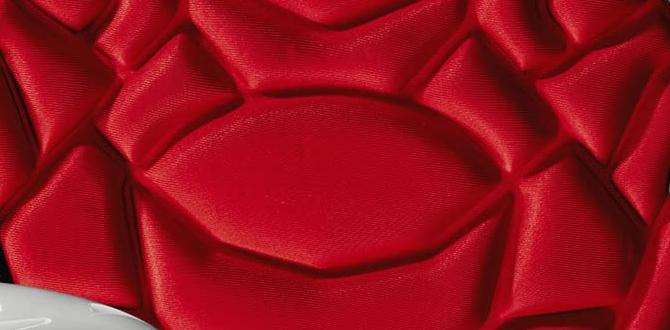Quick Summary: A catcher’s throat guard is a crucial piece of equipment to protect a beginner’s delicate throat from errant pitches and foul tips. This guide will help you choose, fit, and understand why it’s an absolutely essential part of your catcher’s gear for safe and confident play.
Getting behind the plate is exciting! The roar of the crowd, the crack of the bat, and the thrill of making the play – it all starts with being ready. But before you even step on the field as a catcher, there’s one piece of gear that demands your attention: the throat guard. Why such a fuss about this seemingly small part of your equipment? Because a fast-moving baseball can be unforgiving, and your throat is incredibly vulnerable. Many beginner catchers, or their parents and coaches, might wonder if it’s really necessary. We’re here to tell you it absolutely is. It’s not just about looking the part; it’s about staying safe and building confidence so you can focus on developing your skills. Let’s break down exactly why this piece of equipment is so important and how to make sure you have the right one for your game.
Why Every Beginner Catcher Needs a Throat Guard
When you’re just starting out as a catcher, your focus is on getting the signals, blocking pitches, and throwing runners out. It’s a lot to take in! While you’re learning these vital skills, it’s easy to overlook the importance of protecting yourself from direct impacts. A catcher’s throat guard isn’t just another piece of plastic; it’s a specialized piece of protective equipment designed to absorb or deflect impacts that could otherwise cause serious injury. Think of it as your first line of defense for a very sensitive area.
The physics of baseball are simple: a small, hard ball traveling at high speeds can cause significant damage. A stray pitch, a foul tip that sneaks past your mitt, or even an accidental collision can all put your throat at risk. Unlike an outfield fly ball, a pitch or foul tip comes straight at you, often with little warning, especially when you’re still developing your reaction time. For beginners, who are still mastering their stance, tracking pitches, and anticipating plays, the likelihood of an unexpected impact is higher. This is where a good throat guard becomes indispensable.
Beyond the physical protection, wearing a throat guard can significantly boost a beginner’s confidence. Knowing you have that extra layer of safety allows you to focus more on the game and less on potential injuries. This confident mindset is crucial for developing quickly and enjoying the position to its fullest.
Understanding the Anatomy of a Catcher’s Throat Guard
Catcher’s throat guards might look simple, but they are designed with specific features to offer maximum protection. Understanding these components will help you make an informed decision when choosing one.
Key Components of a Throat Guard:
- Material: Most throat guards are made from durable, impact-resistant plastics like high-density polyethylene (HDPE) or polycarbonate. These materials are chosen for their ability to withstand forceful blows without cracking or shattering.
- Shape and Design: The guard is typically shaped to conform to the wearer’s jawline and neck, providing coverage from below the chin down to the upper chest area. Some designs are more sculpted for better fit and comfort, while others are more basic.
- Attachment System: This is a critical feature. Throat guards usually attach to the catcher’s mask. This can be done via straps, clips, or by being integrated directly into the mask design. A secure attachment is vital so the guard stays in place during play.
- Padding (Optional but Recommended): Some advanced throat guards may have a thin layer of padding on the inside to add comfort and further absorb shock.
The effectiveness of a throat guard lies in its ability to deflect or absorb the energy from an impact. When a ball strikes the guard, the material distributes the force over a larger area and away from the vulnerable throat and neck structures. This can prevent direct impact injuries, reduce the severity of any resulting bruising, and potentially save a player from a serious medical emergency.
Types of Throat Guards for Beginners
For beginners, the primary goal is effective protection that’s easy to use and comfortable. There are a few main types of throat guards you’ll encounter:
1. Universal Clip-On Throat Guards
These are the most common and often the most affordable option for beginners. They are designed to attach to virtually any catcher’s mask with a standard cage. They typically clip or strap onto the bottom bars of the mask.
- Pros: Versatile, works with most masks, relatively inexpensive, easy to install and remove.
- Cons: Fit can sometimes be a bit generic, might shift slightly if not secured properly, attachment points can be a weak spot if designed poorly.
2. Integrated Throat Guards
Some catcher’s mask manufacturers design their masks with an integrated throat guard. This means the guard is a permanent part of the mask’s structure, often molded as one piece or securely bolted on.
- Pros: Typically offers a more secure fit, often designed to complement the mask’s aerodynamics and protection, less likely to detach.
- Cons: Less versatile (tied to a specific mask model), can be more expensive, replacing a damaged guard means replacing the whole mask.
3. Full Jaw/Throat Protector (Less Common for Beginners)
While not typically what a beginner catcher would start with, some more advanced gear includes extended protection that covers more of the jaw and lower face. For most young players, a standard throat guard is sufficient and meets requirements.
When choosing, consider how the guard will attach to your current mask. Most manufacturers provide clear instructions, but if you’re unsure, it’s always best to ask a coach or experienced player. For beginners, a sturdy, well-fitting clip-on guard is usually the best starting point.
Choosing the Right Throat Guard: Key Considerations
Selecting the right throat guard involves more than just picking the first one you see. A good fit and solid construction are paramount for effective protection and comfort. Here’s what to look for:
Factor 1: Fit and Secure Attachment
The most crucial aspect is how well the guard attaches to your mask and how stable it is. A guard that’s too loose can shift out of position when you move, leaving you exposed. Look for guards with strong clips, adjustable straps, or a design that clearly indicates compatibility with your specific mask model.
Factor 2: Material and Durability
As mentioned, look for impact-resistant plastics. While you don’t need the absolute most expensive, cheapest options might not offer the same level of protection or longevity. Check reviews or ask for recommendations on brands known for durability.
Factor 3: Coverage Area
Ensure the guard extends far enough down to cover the vulnerable part of your throat. It should also be wide enough to offer protection against angled foul tips. Most standard guards provide adequate coverage, but it’s worth a visual check.
Factor 4: Comfort
While not as critical as protection, comfort matters. If the guard feels awkward or digs into your neck, you might be tempted to adjust it or even remove it. Some guards have slightly more ergonomic designs or smoother edges than others.
Factor 5: Local League/Association Rules
This is a very important point, especially for younger players. Baseball organizations often have specific regulations regarding mandatory protective equipment. Many youth leagues and even higher levels require a throat guard on catcher’s masks. Always check your league’s rulebook or ask your coach to ensure your gear complies. For example, the Little League Official Regulations and Policies often details equipment requirements to ensure player safety.
How to Properly Attach and Fit Your Throat Guard
Getting the throat guard on correctly is just as important as choosing the right one. A poorly attached guard can be useless, or even worse, a hazard.
Step-by-Step Attachment Guide:
- Identify Attachment Points: Examine your catcher’s mask. Most masks have horizontal bars at the bottom of the cage where clips or straps are designed to connect.
- Position the Guard: Hold the throat guard up to the mask. The curved part should be facing inward towards your face, and the part designed to extend downwards should be positioned below your chin.
- Secure the Clips/Straps:
- Clip-On Guards: Align the clips over the bottom bars of the mask and firmly press down until they snap into place. You should hear or feel a distinct click.
- Strap Guards: Thread the straps through or around the mask bars as indicated by the guard’s instructions and fasten them securely. Ensure there’s no slack that would allow the guard to move.
- Test for Stability: Once attached, gently try to wiggle the throat guard. It should feel secure and not move freely. If it’s loose, re-adjust the clips or straps.
- Check for Interference: Put on your catcher’s mask and check if the throat guard interferes with your vision or comfort. It shouldn’t obstruct your view of the field or press uncomfortably against your neck when you’re in your stance.
- Final Check: Make sure the guard is positioned to cover the front of your neck adequately when you’re in a catching position.
If your throat guard came with specific installation instructions from the manufacturer, always follow those first, as mask designs can vary. A snug fit ensures that the guard is in the optimal position to protect you should an impact occur.
Maintenance and Care for Your Throat Guard
Like all sports equipment, taking care of your throat guard will ensure it lasts longer and continues to provide optimal protection. It’s a simple process, but often overlooked.
Cleaning Your Throat Guard:
- After games and practices, wipe down your throat guard with a damp cloth. This removes dirt, sweat, and any field grime.
- For tougher dirt, a mild soap and water solution can be used, followed by a thorough rinse and air dry.
- Avoid using harsh chemicals or abrasive cleaners, as these can damage the plastic.
Inspection for Damage:
Regularly inspect your throat guard for any signs of damage. This is critical for its protective function.
- Cracks: Look for any visible cracks or stress marks in the plastic. Even small cracks can compromise the guard’s integrity.
- Loose Fittings: Check that clips or straps are still secure and haven’t become worn or stretched out.
- Deformation: Ensure the guard hasn’t become misshapen from extreme heat or impact, which could affect its fit and protective capability.
If you find any significant damage, it’s time to replace the throat guard. A damaged guard simply cannot provide the reliable protection you need. Remember, this is a piece of safety equipment, and its condition directly impacts your well-being on the field.
Tips for Beginners Using a Throat Guard
Wearing a throat guard is essential, but making the most of it involves a few simple habits and mindsets.
Embrace it as Part of Your Gear
Don’t see it as an annoyance. Understand that it’s as vital as your helmet and chest protector. The more you get used to wearing it, the less you’ll notice it.
Practice in it
Wear your throat guard during all your catching drills, not just during games. This helps you get accustomed to any slight differences in feel or vision and ensures you’re always protected.
Stay Aware
While the guard offers protection, it’s not a license to be reckless. Always maintain good catching fundamentals, focus on tracking the ball, and try to get your body in front of pitches.
Communicate with your Pitcher
A good relationship with your pitcher can lead to fewer wild pitches. Talk about signs, locations, and what to do if a pitch gets away.
Know the Rules
As mentioned before, ensure your setup complies with league rules. This might seem like a minor point, but it can save you hassle and ensure you’re playing by the book.
For beginner catchers, building good habits early is key. Approaching your gear, including your throat guard, with seriousness and understanding will help you develop into a safer and more effective player.
The Impact of a Throat Guard on Catcher’s Confidence
Confidence is a huge part of playing catcher. You’re the leader on the field, constantly making decisions under pressure. Knowing you’re protected can significantly boost that confidence, especially for beginners who are still getting used to the speed and intensity of the game.
Think about it: when you’re worried about getting hit in the throat, you might flinch, hesitate, or unconsciously pull back slightly. This can affect your ability to block pitches effectively or catch the ball cleanly. But when you have a reliable throat guard, that worry is significantly reduced. You can focus on the pitch, your stance, and the play without that nagging fear of a painful impact.
This sense of security allows beginners to play more aggressively and with greater focus. They’re more likely to jump on passed balls, block pitches in the dirt, and make aggressive plays on runners. This improved performance, in turn, builds even more confidence. It’s a positive feedback loop that starts with a simple piece of protective gear.
In essence, the throat guard acts as a confidence builder. It removes a significant potential threat, allowing budding catchers to concentrate on developing the complex skills required for the position. This is why it’s not just about physical safety; it’s about creating the mental space for growth and enjoyment.
Frequently Asked Questions (FAQ) about Catcher’s Throat Guards
Q1: Is a throat guard really necessary for beginner catchers?
A: Yes, absolutely. While beginners might not be facing 90 mph fastballs, foul tips and errant pitches can still cause serious injury. A throat guard provides essential protection for a vulnerable area and helps build confidence.
Q2: How do I know if my throat guard is attached correctly?
A: A correctly attached throat guard will feel secure to the mask and will not wiggle or shift significantly when you move your head. It should cover the front of your neck comfortably when you are in a catching stance.
Q3: Can any throat guard be used with any catcher’s mask?
A: Most universal clip-on throat guards are designed to fit most standard masks. However, it’s always best to check the compatibility listed by the manufacturer or consult your coach to ensure a secure and proper fit.
Q4: How often should I replace my throat guard?
A: You should inspect your throat guard regularly for any cracks, chips, or loose fittings. If you notice any damage, or if the guard has been subjected to a significant impact, it should be replaced immediately, regardless of age.
Q5: Will a throat guard affect my ability to breathe or see?
A: A properly fitted throat guard should not impede your breathing or vision. If it does, it’s likely not attached correctly or is the wrong size/shape for your mask and head. Make sure it sits comfortably below your chin without obstructing your view.
Q6: Where can I find information on league rules regarding catcher’s equipment?
A: You can usually find this information on your local league’s official website or by consulting the rulebook for your age group. Your team’s coach or manager is also a great resource for clarifying equipment requirements.
Conclusion: Prioritize Protection for a Stronger Game
As you step into the catcher’s position, remember that protection is not optional – it’s fundamental. The catcher’s throat guard, often a simple piece of equipment, plays a vital role in keeping you safe behind the plate. It shields you from the sting of foul tips and the unpredictable nature of errant pitches, allowing you to focus on developing your skills and making game-changing plays. By understanding the types of guards available, ensuring a proper fit, and committing to regular maintenance, you’re investing in your safety and your confidence.
Don’t overlook this essential piece of gear. Embracing your throat guard as a critical component of your catcher’s equipment will not only protect you but also empower you to play with the boldness and focus that the position demands. So, get the right guard, secure it properly, and step behind the plate ready to make every play with confidence and safety. Your commitment to protection today builds the foundation for a healthier, more successful baseball journey tomorrow.




